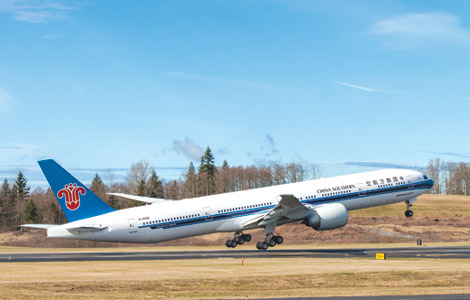China ignores ticking time bomb of increasing waistlines
Updated: 2014-02-27 12:08
By Chen Weihua (China Daily USA)
|
||||||||
One of the many problems that China and the United States could join together to fight is seen in both countries: exploding waistlines.
The latest study from the US Centers for Disease Control and Prevention on Tuesday showed one-third of US adults and 17 percent of children and teenagers are obese. The figures for 2011-2012 show little change in youth and adults compared with the numbers in 2003-2004. However, changes took place within certain age groups. While older women put on weight, very young children have become slimmer.
The biggest achievement seems to be in the 2 to 5 age group where the obesity rate dropped by nearly 43 percent during the period, to 8 percent from 14 percent.
Just a few decades ago, foreign tourists carrying a big belly often drew the eyeballs of curious Chinese. Obesity was a word rarely used. In the years of food scarcity even in the 1970s and early 1980s, no one worried about or even talked about losing weight.
Unfortunately, rapid economic growth in the past three decades also means that Chinese have caught up quickly in weight and waistline, as did many other developing nations.
A report released last month by the UK-based Overseas Development Institute showed that one-third of all adults across the world, or 1.46 billion, are overweight or obese. But in the developing world from 1980 to 2008, the number of people affected more than tripled, to 908 million from 250 million.
In China, the overall obesity rate nearly doubled in the past 30 years, according to the report, Future Diets.
A separate study by China's National Center for Cardiovascular Diseases revealed that overweight and obesity rates of Chinese over the age of 18 hit 240 million and 70 million, respectively. It literally means that one-third of the Chinese adults are either overweight or obese.
Liang Xiaofeng, deputy chief of the Chinese Center for Disease Control and Prevention, said last year that the obesity rate of children under the age of 5 in Chinese cities soared to 8.5 percent in 2010 from 5.3 percent in 2005. Overall, about 120 million Chinese under 18 are considered obese.
The Obesity Reviews published by the International Association for the Study of Obesity a year ago also showed that 12 percent of Chinese children were overweight, resulting in a high incidence of diabetes and high risk of cardiovascular diseases.
There is no doubt that all studies point to a fast growing obesity rate among the Chinese population, especially among the younger population and those living in cities.
The increased consumption of meat products, fat, salt and sugar, often associated with the modernization of lifestyle in developing countries like China, has been blamed as one of the major culprits.
Increasingly, health experts in China advise parents not frequently take their children to fast-food chains such as KFC and McDonald's, which have enjoyed explosive growth in China in the past decades.

For example, KFC has opened 4,600 restaurants in 900 cities in China since its debut there in 1987. The number equals the total in the US where KFC started in 1930.
Meanwhile, McDonald's plans to add 300 restaurants in China this year to bring the total number there to 2,000 by the end of this year.
It's common to see Americans taking vegetable salad and fruit as lunch. But in China, few people today seem to relish the traditional Chinese diet, which scientists have found to be healthy and which former US President Bill Clinton has touted and followed.
The so-called China Study is a research on rural Chinese diet published in 2005 by American medical professors which found that people who eat a whole-food, plant-based/vegan diet, avoiding all animal products, including beef, pork, poultry, fish, eggs, cheese and milk and reducing their intake of processed foods and refined carbohydrates, will escape and reduce or reverse the development of numerous diseases.
Diet aside, one scene that is often missing in China compared with US cities is the fewer young people who exercise on a daily basis. Chinese tourists coming to Washington are often surprised to see throngs of people jogging in the evening, along the Potomac River, Rock Creek Park or just on sidewalks.
In China, the situation is worse for school children, especially those in the kindergarten, elementary and secondary schools. Many physical education teachers, who worry that they might be sued by parents if the students, often the only child in the family, get injured in school sports, have resorted to reduced sports activities.
Health experts have already become deeply concerned that China's growing obesity rate, and all the diseases associated with a bigger waistline, will take a huge toll in the nation's fragile health care system.
But the urgency to deal with the obesity time bomb does not seem to be widely acknowledged by the society and the government.
Contact the writer at chenweihua@chinadailyusa.com
(China Daily USA 02/27/2014 page2)

 US first lady dances with kindergarten kids
US first lady dances with kindergarten kids
 Death-defying skywalkers post stunning images
Death-defying skywalkers post stunning images
 Ibsen gets a Chinese spin in New York
Ibsen gets a Chinese spin in New York
 LA rolls out the red carpet
LA rolls out the red carpet
 Airline receives its first Boeing 777-300
Airline receives its first Boeing 777-300
 Freediver takes cheeky selfie with sperm whale
Freediver takes cheeky selfie with sperm whale
 Buried gold coins unearthed in California
Buried gold coins unearthed in California
 Beaming with pride
Beaming with pride
Most Viewed
Editor's Picks

|

|

|

|

|

|
Today's Top News
China issues report on US human rights
Climate law summit gets started
Apple Inc sues China on IP
Program to help US minority youth
China ignores ticking time bomb of increasing waistlines
US VP welcomes new Ukrainian govt
Shanxi Taxus Pharma to acquire US medical firm
DPRK launches short-range missiles
US Weekly

|

|






